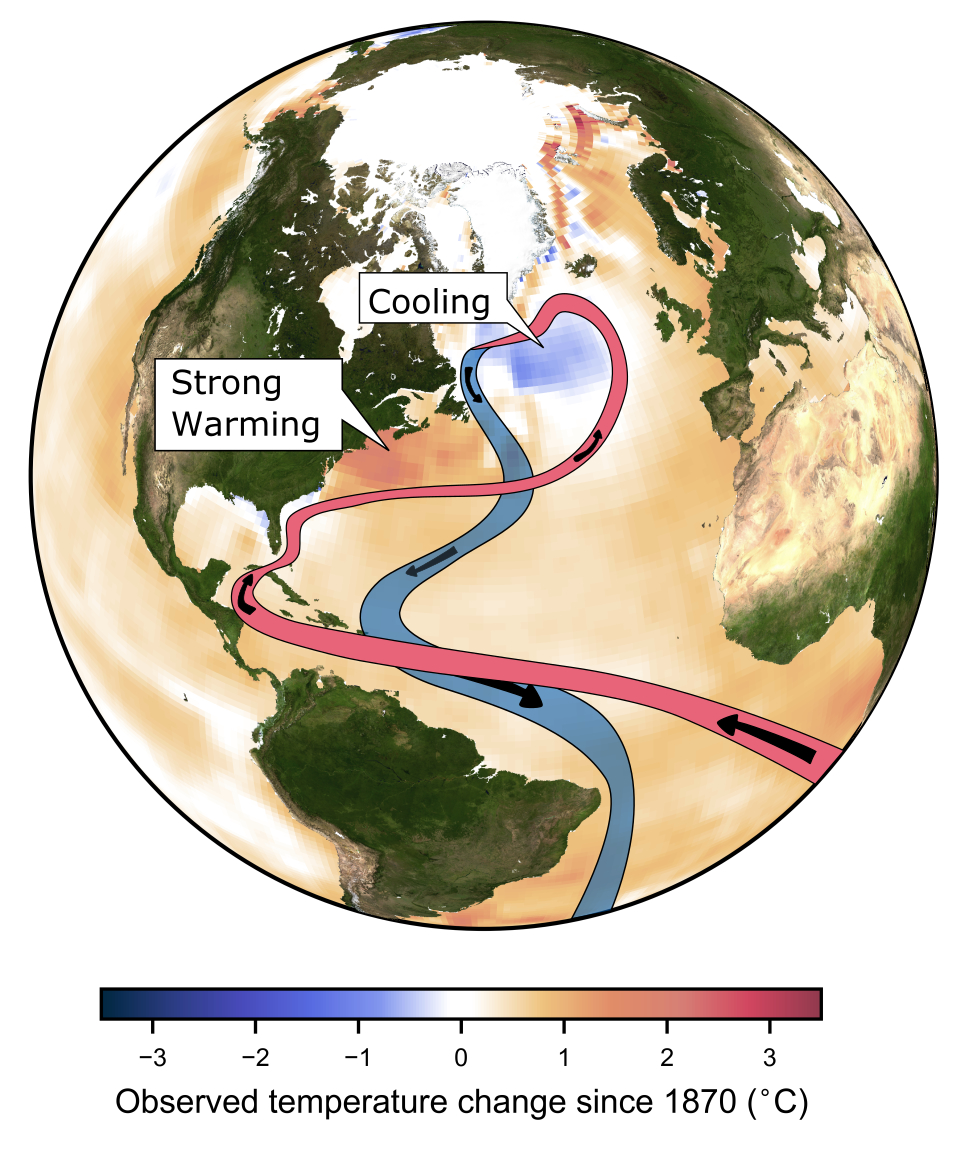What If the Ocean's Climate-Controlling 'Conveyor Belt' Came to a Halt?

Freak floods drown buildings, bone-chilling air flash-freezes pedestrians and ice encases the Statue of Liberty. It sounds like a disaster movie, and well, it is: In 2004's "The Day After Tomorrow," the collapse of an ocean current in the North Atlantic sends the world into a whirlwind climate doomsday.
And while that ocean current has not actually collapsed, scientists reporting in two new studies have found that it's weakening, by a lot. In fact, the current hasn't been this sluggish in 1,500 years — a finding that could carry serious (although not disaster-movie serious) repercussions for weather and sea-level rise in locations around the world.
In the Atlantic Ocean, the current known as the Atlantic Meridional Overturning Circulation (AMOC) ferries warm surface waters northward — where the heat is released into the atmosphere — and carries cold water south in the deeper ocean layers, according to the National Oceanic and Atmospheric Administration. Its circulation transports heat around the globe like a conveyor belt, and if its movement were to stop, that heat would not get distributed, and weather havoc could ensue. [Doomsday: 9 Real Ways Earth Could End]
But the AMOC has been getting weaker, and cold, freshwater infusions by the runaway melting of glaciers, sea ice and permafrost are to blame, and the AMOC may weaken even further if temperatures on Earth continue to rise and ice reserves continue to melt, scientists reported in the two studies.
Written in sand
In one study, published yesterday (April 11) in the journal Nature, researchers analyzed ocean sediments in a core sampled off the eastern coast of the U.S., from depths where most of the water originated in the North Atlantic's Labrador Sea. They examined positions of different-size sand grains in the geologic record, to reconstruct how the flow of the currents that carried the grains may have changed over time, said study co-author Delia Oppo, a senior scientist in the geology and geophysics department at the Woods Hole Oceanographic Institution.
The researchers traced the start of the current's weakening to the mid-19th century at the end of the Little Ice Age, a centuries-long period of extreme cold that froze northern Europe. When temperatures began warming up, freshwater from melting ice that flowed into the Nordic Seas would have diluted salty seawater near the surface. This weakened the current and prevented it from carrying bigger grains of sand as far as it used to, which told the scientists about differences in the current's strength, Oppo told Live Science.

Then, beginning in the 1950s, another stage of warming and ice melt began in the Northern Hemisphere — this time, likely driven by human-induced climate change — infusing the sea with more chilly fresh water and further weakening the ocean circulation system, study lead author David Thornalley, a senior lecturer at University College London, told Live Science in an email.
Sign up for the Live Science daily newsletter now
Get the world’s most fascinating discoveries delivered straight to your inbox.
"Theory and models show the AMOC weakens when there is warming and increased input of freshwater, and these are both things being observed as part of global warming," Thornalley said. The research team estimated that, since the current began to lose strength in the mid-1800s, it has weakened by about 15 to 20 percent.
Finding the "fingerprint"
Another study, also published today in Nature, arrived at the same conclusions about a weakened AMOC — this time, by reviewing sea-surface temperature data going back to the late 19th century. In this study, the researchers' temperature analysis confirmed computer models' predictions of AMOC behavior and suggested a decline of about 15 percent in current circulation strength, beginning in the 1950s.
"The evidence we're now able to provide is the most robust to date," study co-author and oceanographer Stefan Rahmstorf, a professor of physics of the oceans at the Potsdam Institute for Climate Impact Research in Germany, said in a statement.
The researchers detected an ocean temperature pattern that was a "fingerprint" for an AMOC slowdown: anomalous warming in the Gulf Stream and cooler waters near Greenland, suggesting that warm water was not being transported north as effectively as it once was, according to the study.
"The specific trend pattern we found in measurements looks exactly like what is predicted by computer simulations as a result of a slowdown in the Gulf Stream system," Rahmstorf said. "And I see no other plausible explanation for it."
Though these two research teams used different methods, they arrived at a similar conclusion: that a crucial part of the climate system on our dynamic planet is not performing as it once did.
"What's happening now is that the evidence is converging from different sources," Oppo told Live Science. "So, we're becoming more and more confident, as we see several studies starting to show similar things using different approaches." [7 Ways the Earth Changes in the Blink of an Eye]
An uncertain future
While the complete disintegration of the AMOC is extremely unlikely, the ocean circulation system will probably continue to weaken, and that prospect is far from reassuring, Oppo told Live Science. Prior research has suggested that a feeble AMOC brings more dryness to the Sahel, a region of Africa bordering the Sahara Desert; spurs sea-level rise in U.S. coastal cities; encourages patterns of increasingly cold winters in Europe and the northeastern U.S.; and prompts warmer summers across Europe. However, more research is needed to confirm a persistent connection, Oppo said.
But a weakened AMOC does make the ocean less effective at absorbing atmospheric carbon dioxide, Oppo noted. If the ocean current continues to weaken, it will likely take up even less CO2, leading to higher quantities of the greenhouse gas in the atmosphere and potentially worsening the effects of global warming, she said.
"More research into the potential weather impacts of an AMOC slowdown and the associate sea surface temperature pattern is needed, given the results of the two new studies suggesting a weak AMOC that is likely to weaken further," Thornalley told Live Science.
Editor's Note: This article was updated to clarify some statements from Delia Oppo.
Original article on Live Science.

Mindy Weisberger is an editor at Scholastic and a former Live Science channel editor and senior writer. She has reported on general science, covering climate change, paleontology, biology and space. Mindy studied film at Columbia University; prior to Live Science she produced, wrote and directed media for the American Museum of Natural History in New York City. Her videos about dinosaurs, astrophysics, biodiversity and evolution appear in museums and science centers worldwide, earning awards such as the CINE Golden Eagle and the Communicator Award of Excellence. Her writing has also appeared in Scientific American, The Washington Post and How It Works Magazine. Her book "Rise of the Zombie Bugs: The Surprising Science of Parasitic Mind Control" will be published in spring 2025 by Johns Hopkins University Press.










